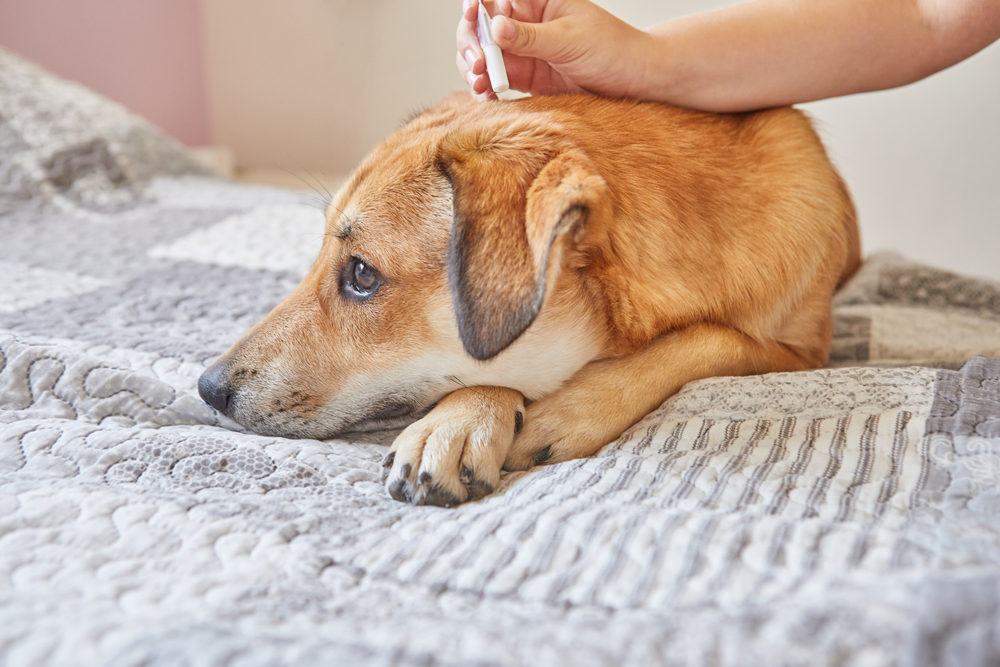
Safe use of flea and tick products for your pets
With the warm weather, we are all getting out with our pets and enjoying the sun especially after winter storm Uri. In Texas, fleas and ticks are a year round issue for your pets.
Flea bites may be more than an itchy annoyance to some dogs and cats. They can cause flea allergy dermatitis — an allergic reaction to proteins in flea saliva. And a pet’s constant scratching can cause permanent hair loss or other skin problems. In severe infestations, fleas feasting on your pet’s blood can lead to anemia and, in rare cases, death.
Ticks can also harm your pet, transmitting tick-borne infections such as Lyme disease, Ehrlichiosis, Anaplasmosis, Rocky Mountain Spotted Fever, Babesiosis, and Bartonellosis. And pets can bring ticks into the home, exposing you and your family to illness from a tick bite.
Hundreds of pesticides, repellents, and growth inhibitors are available to protect your pet from flea and tick bites. Some of these products are available only from a veterinarian; others can be bought over the counter.
Flea and tick products range from pills and chews given by mouth to collars, sprays, dips, shampoos, powders, and “spot-ons,” liquid products squeezed onto the dog’s or cat’s skin usually between the shoulder blades or down the back. A few spot-on products are available for flea control in ferrets, and fly and tick control in horses.
Although flea and tick products on the market have been used in millions of pets, side effects or adverse events may and sometimes do occur. It’s strongly recommended that you involve your veterinarian when choosing a flea and tick product, especially if your pet has any health conditions.
You should also carefully read the label, the package insert, and any accompanying literature to make sure you’re using the product correctly. You should also save the packaging for the product in case a problem does occur and you need to report it.
When to Treat
 Your veterinarian can help you determine the best time frame for treating your pet.
Your veterinarian can help you determine the best time frame for treating your pet.
Generally speaking, it’s best to start treating your pet at the beginning of flea season if you’re trying to prevent a flea infestation.
The length of the flea season, which peaks during warm weather months, varies depending on where you live.
If you live in a colder climate, it might only last four months or so. In other places, like Florida, fleas can live all year long.
Fleas can live inside a warm house year-round no matter where you live.
Ticks are found in some places year-round. The Centers for Disease Control and Prevention report that in most parts of the U.S., the greatest chance of being bitten by a tick is in spring and summer, with another spike in the fall.
Tips for Using Topical Flea and Tick Products
There are many different types of flea and tick products that can be applied to your pet, and different chemicals work in different ways. That’s why it’s always important to:
Choose the right product
- Work with your veterinarian to select the right product for your pet and your needs.
- Make sure the product matches your pet’s species, life stage, and weight class. If the product is for use on dogs, don’t use it on cats. If using the product on a puppy or kitten, make sure it is labeled for that life stage and that your pet is at least the minimum weight specified on the label.
- Don’t apply a product to kittens or puppies unless the label specifically allows this treatment. Use flea combs to remove fleas and flea eggs, and a tick remover to take off ticks from puppies and kittens that are too young for flea and tick products.
- Talk to your veterinarian before using a product on weak, old, medicated, sick, pregnant, or nursing pets, even if they have been fine with previous uses of the product. The same goes for pets that have previously shown signs of sensitivity to flea or tick products. Tell your veterinarian about any other products you might be using or giving to your pet because it could make a difference in their recommendations.
Use the product properly
- Read the label carefully before use. Even if you’ve used the product many times before, read the label because the directions or warnings may have changed. If you don’t understand the wording, ask your veterinarian or call the manufacturer.
- Follow the directions exactly. If the label says use weekly, don’t use it daily. If the product is for use in the house or yard, don’t put it directly on your pet.
- If you have multiple pets and are using spray or “spot-on,” products, apply to one pet at a time and keep the treated animal separated from the other(s) until the product dries. This is to prevent one animal from grooming another and potentially ingesting the drug or pesticide. This is especially important if the product is only for use in dogs and you have a cat in your household.
- Wash your hands immediately with soap and water after applying a product or use protective gloves while applying.
- Store products away from food or things that could come into contact with a person’s mouth, like baby pacifiers, inhalers, and cigarettes.
- Keep products out of the reach of children and pets.
Pay attention after using the product
- Monitor your pet for side effects or adverse events after applying the product, particularly when using the product on your pet for the first time. Side effects might occur immediately or could happen sometime later.
- If your pet experiences a bad reaction from a flea and tick collar, remove the collar immediately.
- If your pet experiences a bad reaction from any flea or tick product (spot-on, shampoo, dip, or collar), call your veterinarian right away. Depending on the product used, your veterinarian may recommend that you immediately bathe the pet, if it’s safe to do so, using mild dish soap and rinsing with large amounts of water.
- Call your veterinarian if your pet shows symptoms of illness after using a product. Look for dizziness, wobbliness, incoordination, poor appetite, depression, vomiting, diarrhea, or excessive salivation. Some animals have had seizures and/or died.
Fleas and ticks can be more than just an itchy annoyance to your pets—they can cause serious harm. So it’s important to know how to use flea and tick products safely. It’s also important to know whom to report to if you’re experiencing problems with these products.
Flea and tick products for pets are regulated by either the Food and Drug Administration or the Environmental Protection Agency (EPA). FDA and EPA have an interagency committee that evaluates products on a case-by-case basis to determine the appropriate regulatory agency.
Generally speaking, the FDA is responsible for approving animal drugs and regulates flea and tick products that are given orally, including pills, chews, and swallowable liquids, or by injection.
EPA, with some exceptions, regulates those products that are applied to pets topically – to pets’ skin or fur. This includes shampoos, collars, dust or powder, sprays, and spot-on flea and tick products.
The appropriate agency bases its evaluation on a thorough review of detailed information on the product’s safety and effectiveness. This information is provided by the manufacturer or other product sponsor. The sponsor must show that the drug or pesticide meets current safety standards to protect:
- the animal,
- people in contact with the animal, and
- the environment.
The sponsor must also show that the drug or pesticide achieves the claimed effect, and the product must carry specific labeling so that it can be used safely and effectively.
Although flea and tick products are very commonly used across pets of multiple sizes, ages, and health profiles (as directed on the label) with no problems, side effects can occur. Consumers can report side effects to both the FDA and EPA, as well as product manufacturers.
For that reason, it’s good to hold on to the product packaging so that you have the contact information for the manufacturer, as well as details like the lot number.
You can tell which agency regulates the product by looking at the packaging. For FDA-regulated products, look for the letters “NADA” or “ANADA,” followed by a six-digit number in this format: NADA-xxx-xxx or ANADA xxx-xxx. Products regulated by EPA will carry an EPA registration number: EPA Reg. No. xxxxx-xxxxx.
These numbers help identify the exact product better than the name of the product alone.
- To report problems with FDA-approved flea or tick drug products, contact the drug manufacturer directly (see contact information on product labeling) or report to FDA’s Center for Veterinary Medicine on a Form FDA 1932a. For more information, please visit www.fda.gov/reportanimalae.
- To report problems with EPA-regulated products, contact the manufacturer directly (see contact information on product labeling), EPA External Link Disclaimer, or the National Pesticide Information Center External Link Disclaimer (NPIC) at 1-800-858-7378.
- If your pet needs immediate medical care, call your local veterinarian, a local animal emergency clinic, or the National Animal Poison Control Center External Link Disclaimer at 1-888-426-4435. The NAPCC charges a fee for a consultation.
Source: U.S. Food & Drug Administration






